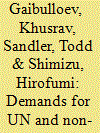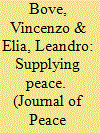| Srl | Item |
| 1 |
ID:
092046


|
|
|
|
|
| Publication |
2009.
|
| Summary/Abstract |
This article presents alternative estimates for the demand for UN and non-UN peacekeeping. Generally, three-way fixed-effects models, which account for the country, year, and conflict region, provide the best estimates. The demand for UN peacekeeping is primarily influenced by the contributions of other nations (i.e., spillins), with spillin elasticity not significantly different from 1. For non-UN peacekeeping, both spillins and country-specific interests in the conflict region influence contributions. These peacekeepers' interests include trade and FDI concerns, along with proximity to the conflict. Peacekeeping missions appear partitioned: UN missions for global public benefits and non-UN missions for peacekeeper-specific benefits.
|
|
|
|
|
|
|
|
|
|
|
|
|
|
|
|
| 2 |
ID:
109191


|
|
|
|
|
| Publication |
2011.
|
| Summary/Abstract |
We explore the supply side of peacekeeping - the determinants of a country's voluntary contributions to peacekeeping operations. We focus on troop contribution and examine a large set of operations, from UN-led missions to operations led by NATO, the African Union, the European Union, and ad hoc coalitions. We rely on a theoretical model of the private provision of public goods and a dataset on troop contribution across 102 states and 45 operations from 1999 to 2009 to explain both the conditions under which third-party actors are more or less likely to intervene in peacekeeping operations and the factors determining the size of their personnel contribution. We use the characteristics of the conflict to identify which types of conflicts attract outside intervention and the characteristics of the intervener to identify the countries more willing to provide troops. We show that at the domestic level, contributions are driven by the comparative advantage in manpower - or the relative value of labor - and constrained by the tolerance of casualties and the sustainability of multiple and concurrent missions. At the international level, the most robust explanations of when states choose to intervene are the level of threat to global and regional stability, the proximity to the conflict area, and the number of displaced people. In particular, security and humanitarian concerns trigger nation-specific responses. Our empirical findings provide further evidence of the centrality of country-specific gains in explaining the participation in peacekeeping. However, contributor-specific benefits play the same role in UN and non-UN peacekeeping missions, in contrast with previous empirical studies on the financial burden-sharing.
|
|
|
|
|
|
|
|
|
|
|
|
|
|
|
|